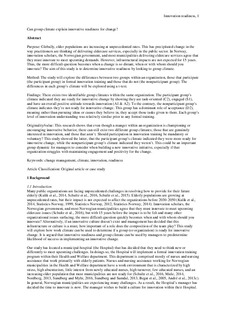| dc.contributor.author | Schultz, Joseph Samuel | |
| dc.contributor.author | Sjøvold, Endre | |
| dc.contributor.author | Andre, Beate | |
| dc.date.accessioned | 2017-10-20T10:38:58Z | |
| dc.date.available | 2017-10-20T10:38:58Z | |
| dc.date.created | 2017-02-01T08:36:37Z | |
| dc.date.issued | 2017 | |
| dc.identifier.citation | Journal of Organizational Change Management. 2017, 30 (3), 440-452. | nb_NO |
| dc.identifier.issn | 0953-4814 | |
| dc.identifier.uri | http://hdl.handle.net/11250/2461238 | |
| dc.description.abstract | Purpose
Globally, elderly populations are increasing at unprecedented rates. This has precipitated change in the way practitioners are thinking of delivering eldercare services, especially in the public sector. In Norway, innovation scholars, the Norwegian government, and most municipalities delivering eldercare services agree that they must innovate to meet upcoming demands. However, infrastructural impacts are not expected for 15 years. Thus, the more difficult question becomes when a change is so distant, when or with whom should you innovate? The purpose of this paper is to determine innovative readiness by looking at group climate.
Design/methodology/approach
The study will explore the differences between two groups within an organization: one group that participated (participant group) in formal innovation training and and the other group (nonparticipant group that did not participate in the training). The differences in each group’s climate will be explored using a t-test.
Findings
There exist two identifiable group climates within the same organization. The participant group’s climate indicated that their members are ready for innovative change by showing that they are task oriented (C2), engaged (S1), and have an overall positive attitude toward innovation (A1 and A2). On the contrary, the nonparticipant group’s climate indicates that their members are not ready for innovative change. This group has a dominant role of acceptance (D2), rather than pursuing ideas or causes they believe in, they accept those tasks given to them. Each group’s level of innovation understanding was relatively similar prior to any formal training.
Originality/value
This research shows that even though a manager within an organization is championing or encouraging innovative behavior, there can still exist two different group climates: a group that is genuinely interested in innovation and one that is not. Should participation in innovation training be mandatory or voluntary? This study showed the latter that the participant group’s climate indicated its members were more ready for innovative change, while the nonparticipant group’s climate indicated its members were not. This could be an important group dynamic for managers to consider when building a new innovative initiative, especially if that organization struggles with maintaining engagement and positivity for that change. | nb_NO |
| dc.language.iso | eng | nb_NO |
| dc.publisher | Emerald | nb_NO |
| dc.title | Can group climate explain innovative readiness for change? | nb_NO |
| dc.type | Journal article | nb_NO |
| dc.type | Peer reviewed | nb_NO |
| dc.description.version | acceptedVersion | nb_NO |
| dc.source.pagenumber | 440-452 | nb_NO |
| dc.source.volume | 30 | nb_NO |
| dc.source.journal | Journal of Organizational Change Management | nb_NO |
| dc.source.issue | 3 | nb_NO |
| dc.identifier.doi | 10.1108/JOCM-06-2016-0112 | |
| dc.identifier.cristin | 1444994 | |
| dc.relation.project | Norges forskningsråd: 212215 | nb_NO |
| dc.description.localcode | © Emerald Publishing Limited 2017. This is the authors' accepted and refereed manuscript to the article. | nb_NO |
| cristin.unitcode | 194,60,25,0 | |
| cristin.unitcode | 194,65,20,0 | |
| cristin.unitname | Institutt for industriell økonomi og teknologiledelse | |
| cristin.unitname | Institutt for samfunnsmedisin og sykepleie | |
| cristin.ispublished | true | |
| cristin.fulltext | original | |
| cristin.fulltext | postprint | |
| cristin.qualitycode | 1 | |
